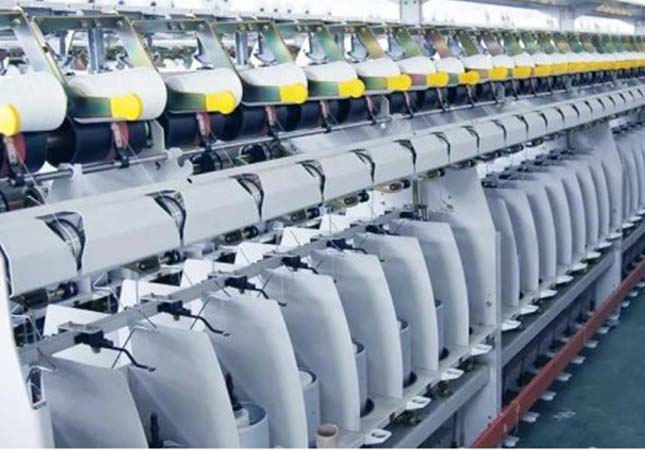Warp tying machine used to knot warp yarns, which is the lengthwise threads that are stretched on a loom to weave fabric which is primarily used in the weaving of complex patterns and designs that require multiple colored yarns or a combination of different types of yarn. This blog will introduce the work process of the warp tying machine roughly and the economic position of the warp tying machine in detail.

The Work Process of Warp Tying Machine
Warp tying machine works by creating knots at specific intervals on the warp yarns, which are then mounted on a loom. The following are the steps of the work process of the warp tying machine.
l The machine usually operates in conjunction with a creel, which is a rack used to hold multiple spools of yarn.
l The warp yarns are fed from the creel to the knotting machine, which then knots them together at predetermined intervals that creates a chain of yarns, which is then wound onto a beam or roller for further processing.
l The beam or roller is then loaded onto the loom, where the warp yarns are stretched and held in place by the loom's comb.
The Economic Position of the Warp Tying Machine
The economic position of the warp tying machine in the textile industry is significant, as it plays a crucial role in improving production efficiency, reducing labor costs, and maintaining product quality. The following are the specific manifestations of the warp tying machine’s economic status.
1. Improved production efficiency
A warp tying machine is capable of knotting the warp ends of fabric quickly and accurately, which reduces the time required for manual knotting, and allows textile manufacturers to increase production speed and volume, which can have a positive impact on their profitability.
2. Reduced labor costs
A warp tying machine can also help to reduce labor costs in the textile industry. The manual knotting of warp ends is a time-consuming and labor-intensive process that requires skilled workers. By automating this process, textile manufacturers can reduce their labor costs and allocate their workforce to other areas of the production process.
3. Improved product quality
Manual knotting can be inconsistent and may lead to knots that are not secure or properly positioned, which can result in a fabric that is unstable during the weaving process and may lead to defects in the finished product. warp tying machines, on the other hand, can tie knots that are consistent and secure, which ensures that the fabric remains stable during weaving and produces a high-quality finished product.
4. Competitive advantage
Textile manufacturers who use a warp tying machine can gain a competitive advantage in the industry. By improving production efficiency, reducing labor costs, and maintaining product quality, they can offer their customers a better product at a lower cost which can help to attract new customers and retain existing ones, which can have a positive impact on their profitability and market share.
5. Technology advancement
The technology used in warp tying machines is constantly advancing, which can improve their economic position in the textile industry. Newer machines may be more efficient, faster, and more reliable, which can help to further improve production efficiency and reduce costs. Manufacturers who invest in newer machines may be able to gain a competitive advantage over those who continue to use older, less efficient equipment.
6. Return on investment
The economic position of the warp tying machine also depends on its return on investment (ROI). The cost of purchasing and maintaining a warp tying machine must be weighed against the savings in labor costs and the increase in production efficiency. If the ROI is positive, the machine can be considered a worthwhile investment that can improve the profitability of the textile manufacturer.
SUNTECH ST-WKM-II Warp Knotting Machine
Here are the key features and benefits of the SUNTECH ST-WKM-II warp knotting machine.
1. High running speed
The ST-WKM-II can operate at a running speed of up to 400 rpm, making it one of the fastest machines of its kind.
2. Increased splitting speed
The actual splitting speed of the machine is 50%-100% higher than its predecessors, depending on the state of the yarn being used.
3. Adjustable splitting benchmark
The machine can split the tissue benchmark in a 1:1 ratio, which can be changed to a 2:2 ratio by simply switching the switch.
4. Single handle warp tension adjustment
Warp tension can be easily adjusted using a single handle.
5. Special warp separation device
The machine comes with a special warp separation device that facilitates corresponding tell operation.
6. Stable and easy to adjust
The main part of the machine is actively driven by a cam, ensuring stability and easy adjustability.
7. Easy exchange of yarn splitting needle
The exchange of the yarn splitting needle is simple and completed in just one step.
Conclusion
Warp tying machine is particularly used in the production of woven fabrics, which is able to tie together the warp ends of a fabric, which is necessary for ensuring that the fabric remains stable during the weaving process, the economic position of the warp tying machine in the textile industry is significant.
As a reputable textile machinery manufacturer with a rich history in automation and intelligent manufacturing technology of textile and warehousing equipment, SUNTECH Textile Machinery possesses cutting-edge core technologies that are recognized globally.
SUNTECH’s products cover the textile manufacturing and handling process of almost fabric types, in which pinking machine, non woven machine, beam truck, meltblown machine, fabric cutting machine, motorized beam trolley, beam storage, warp tying machine are the most popular machines and material handling equipment.
SUNTECH Textile Machinery leads the textile industry with our innovation and experience! Quotes and Cooperation are Highly Welcome!




